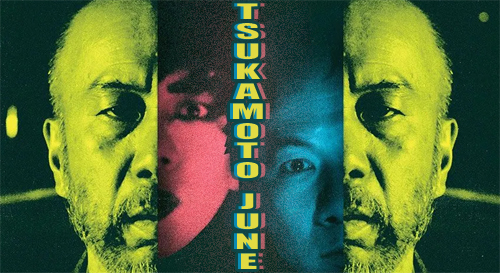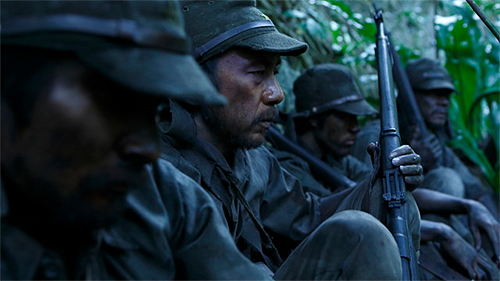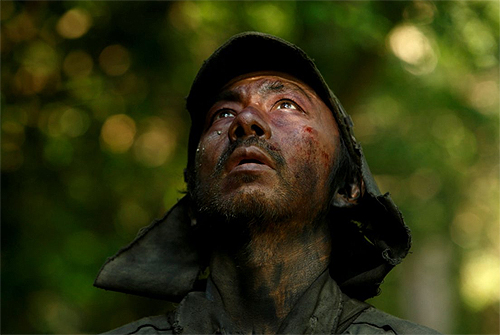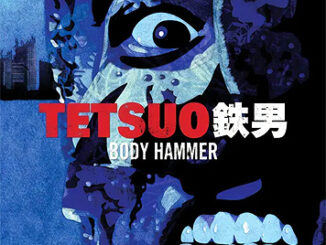Fires on the Plain (2014)
Directed by: Shinya Tsukamoto
Written by: Ooka Shohei, Shinya Tsukamoto
Starring: Lily Franky, Shinya Tsukamoto, Tatsuya Nakamura

Available on demand and from Third Window Films
Welcome to the inferno. And welcome back Tsukamoto fans. Some might say there’s no such thing as a true anti-war film. After all, something is always lost when real life events are changed from a journal to a movie for our trivial entertainment. But the director and actor certainly gives it his best shot here, no pun intended. His films are hardly entertaining in the conventional sense to begin with, so him adapting a historical account is certainly an intriguing prospect. It was originally intended to be an expensive affair, rather than the independent feature which was produced. So it’s also interesting to see what was done with the lower budget. Which is of course nothing new for the film-maker and his company Kaiju Theatre. Let’s peer into the fog and see what horrors lie in wait.

This is a stark film, with little in terms of wartime spectacle and even less context. It never pauses to explain the conflict, and it’s only after thirty minutes that the island of Leyte is even named. It just throws the audience into the chaos, which starts out very slowly but is soon injected with flashes of violence and pyrotechnics. Tamura (Shinya Tsukamoto) is dismissed from his unit, for what is said to be tuberculosis. But at the field hospital he’s sent away because he doesn’t have any serious wounds. This back and forth journey happens more than once, driving home the futile nature of the situation. It’s a desperate time as soldiers bicker over rations and turn into thieves; or worse. After all, under these hopeless circumstances desperate measures are soon to follow. It’s not a question of whether Tamura will crack under the pressure, but when.
He might be starving, but he’s also a coward. Whatever battles his unit passed through are depicted in very limited flashbacks, and it’s up to his dejected face to tell the rest of the story. There are no scenes of national pride or heroism in the face of adversity here. A lot of the story is just this lone figure wandering through the jungle. Sometimes there are instances which depict the beauty of nature. In one scene there’s a brief moment of peace in a Christian church. But these fleeting moments are usually cut short by bullets and bloodshed. Tamura is soon reduced to a bandit looking for supplies, or even lower yet a primal creature searching for fire. It turns out that the yam roots everyone is squabbling over can’t be eaten raw. Without orders, or even a general direction, the troops are more like children or animals than adult men.
Of course there are other inhabitants on the island. Allied patrols occasionally show up, wreaking havoc and reducing the remaining infantry by large numbers at a time. But they’re a faceless enemy, sometimes in unseen fighter planes or behind patrol spotlights. This essential limitation adds to the horror atmosphere of the movie, making the fight seem both impersonal and nightmarish. An uneasy tension grows in between the gruesome attack scenes – accentuated by the way there are no real battle plans. There are no discussions of enemy numbers, and there are no military positions being mapped out. The war is over in more ways than one, but Tamura can’t escape. In one of the subtle moments of dark humour he throws away his rifle – only to be given another by the first friendly unit he meets.

The other locals are Filipino farmers who light the fires of the title. If the themes of the movie are the way war causes desperate hunger and unbridled rage, they represent the latter. The lines are blurred between frenzied guard dogs and seething villagers, both ready to kill Tamura. Just like the fighting the atrocities of the war are never shown. But again they’re clear to read on the expressions of surviving women. They’ve also had part of their humanity taken away and seen great injustice. As a result Tamura and his comrades are left in a hell of their own making. Repeating images, and sounds, depict this cycle of violence and starvation. It’s a film that often feels like a low budget affair thanks to a limited score and the use of harsh digital photography. But all the pieces are put together in a way that make it more than the sum of these parts.
The cyclical and pointless nature of the war is also shown through the supporting cast. Tamura can’t seem to escape a Colonel who claims to be bulletproof, and a duo of soldiers trading cigarettes for yams. He can’t get away from these same faces, or escape the violent deeds he’s committed. It’s repetitive but poignant, like another trip into the underworld. The bizarre labyrinth in Haze might have seemed more surreal, but this is a similar kind of journey into madness. Its inhabitants are all damaged whether they’re hardened cynics or rage fuelled survivors. When tales of men forced to eat human flesh to keep fighting start to surface, it seems like a logical turn of events. It’s just another layer of degeneration, another step in the downward spiral.
The end results are often meandering and depressing, but that’s by design. Characters talk about their homes on very few occasions. There’s no romantic element to the film, despite occasional references to civilian lives and family members. They’ve become pieces of meat led to the grinder – an idea which surfaces in more ways than one. It’s probably got more in common with Tokyo Fist than something like Letters from Iwo Jima. Which means that it’s not an entirely cerebral experience, and there’s still plenty of Tsukamoto’s usual violent special effects and twisted fever dream moments. It’s subdued and occasionally introspective, but it’s punctuated by visceral and bizarre moments that have plenty of shock power. Perhaps it’s too outlandish here and there to be a truly sombre affair, but overall this is certainly an anti-war story at its core.
Rating: 









Other articles in this series:
HAZE (2005)





Be the first to comment